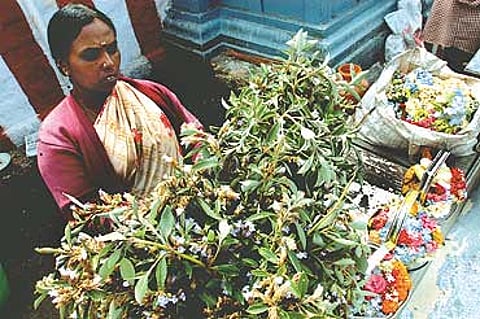All this changed with the planting of the first wattle trees in 1852. The new settlers, seeking urban comforts in the Shola forests, found the area too marshy and waterlogged. The evergreen Shola grasslands ecosystem ensured that the Palani hills received the highest annual rainfall in Tamil Nadu—over 150 cm over 93 days. Such a bioscape engenders hundreds of species of insects and birds. Besides, 46 botanical species, including the kurinji, are endemic to the Kodaikanal forest. For humans to live here comfortably, the water had to be drained. Wattle, pine and eucalyptus—known for deep, water-guzzling roots—were planted on a war-footing by the forest department. The 'colonisation' of Sholas and grasslands by these fast-growing, non-native alien species was soon complete. Today, despite 15 years of decolonising the forests by vtc, the Palani Hills Conservation Council (PHCC) and a forest department on a random correction course, the Shola cover is a meagre 2,367 ha compared to 6,154 ha covered by wattle, 5,404 ha by eucalyptus and 1,872 ha by pine. The grasslands, estimated to account for a mere 4 per cent, are further eroded by agriculture (potatoes, beans and carrots), tea and cardamom estates, and illegal ganja. It is on these grasslands that the kurinji makes its home every 12 years. Today, the kurinji has been virtually served eviction notice from the hills they bathed in blue for years.
After flowering from late April to September at altitudes between 1,600 metres and 2,400 metres, the kurinji dies on itself. Kurinji—then, the honey from the flower—is a rare delight. Karuppachi, a native of Vilpatti village who has witnessed six kurinjis, says the kurinji honey is especially dark brown in colour. Hill tribes like the Todas and Muduvars and early settlers like the Madari revere the kurinji as god. "We never touch, let alone pluck the kurinji stalks or flowers," notes 73-year-old Karuppachi, a member of the Madari community. However, at the Kurinji Andavar (Murugan) temple in Kodaikanal, the flower is offered at Rs 10 for two stalks to tourist-devotees. When the kurinji is in full bloom, the tribes worship it. After it withers, they savour thinai (millet) flour mixed with the kurinji honey, a mixture offered to Lord Murugan. Not just that, the critically endangered Niligri tahr and the Indian gaur (bison) "love its leaves", says a forest department official
The forest department scientist says the threat to the kurinji is part of a larger ecological malaise. "Scores of nectar-yielding plants, shrubs and 10 other species of the kurinji in the Western Ghats, none as rare as the Neelakurinji, are vanishing along with the Sholas and the grasslands. This is, in turn, bringing down the population of bees, thus affecting pollination. The waters streaming out of Palani Hills sustain estuarine rivers that feed the mangroves along the East Coast. The interconnections are mind-boggling." Lately, the entire ecosystem has been jolted by the destruction of the grasslands.
Late taxonomist K.M. Matthew, author of the three-volume The Flora of Palani Hills, headed a committee of the PHCC. He proposed a 73-acre kurinji sanctuary in Kodaikanal, from Coaker's Walk to Priest's Walk, but the Dindigul collectorate is sitting on the proposal since it is technically revenue land. In February this year, the proposed sanctuary area had a massive fire that burnt down most of the grassland. Mathew's dream went up in smoke. Baskaran points out that the Western Ghats are one of 18 biodiversity hotspots in the world. "And the kurinji is a symbol of it.... It is time we acted. The kurinji should not become a relic of nostalgia, a pretty picture." Sadly, the kurinji is desperately in need of sanctuary in its own home.
Once In A Blue Hill
A habitat change is shearing the kurinji bloom of its magic

Published At:
Tags